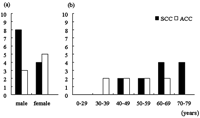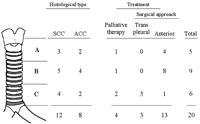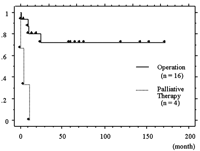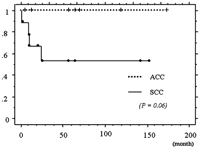-
PDF
- Split View
-
Views
-
Cite
Cite
Kenji Hazama, Shinichiro Miyoshi, Akinori Akashi, Tsutomu Yasumitsu, Hajime Maeda, Kenji Nakamura, Hiroto Tada, Hikaru Matsuda, Clinicopathological investigation of 20 cases of primary tracheal cancer, European Journal of Cardio-Thoracic Surgery, Volume 23, Issue 1, January 2003, Pages 1–5, https://doi.org/10.1016/S1010-7940(02)00728-5
Close - Share Icon Share
Abstract
Objective: Primary tracheal cancer is considered to be relatively rare. Its epidemiology, therapeutic strategy and prognosis are not well understood. Methods: We retrospectively investigated the clinicopathological aspects of 20 patients with primary tracheal cancer. Results: Patients included 11 men and nine women with a mean age of 57.3 years. There were 12 squamous cell carcinomas and eight adenoid cystic carcinomas. Four patients received only palliative therapy. Sixteen patients underwent surgical treatment such as segmental tracheal, laryngotracheal, or carinal resection. One patient with squamous cell carcinoma died of postoperative mediastinitis. Although resected specimens from five patients had tumor positive margins, only one of those patients died after local recurrence and only three patients had postoperative treatment. The 5-year survival rate for patients who underwent surgery was 72.3%. Conclusions: Surgical treatment is the first choice therapeutic modality for primary tracheal cancer in consideration of its prognosis. While performing the operation, safety of the anastomosis should take precedence over completeness of resection.
1 Introduction
Primary tracheal cancer is considered to be relatively rare [1–3], accounting for approximately 0.2% of all malignancies of the trachea and bronchus [4]. There have been few reports of its epidemiology, therapeutic strategy, and prognosis [5,6].
We reviewed patients with primary tracheal tumors in the affiliated hospitals of Osaka University.
2 Materials and methods
Between 1979 and 2000, 20 patients with a primary tracheal cancer were admitted to one of the following hospitals: Osaka University Hospital, Takarazuka Municipal Hospital, Osaka Prefectural Habikino Hospital, National Kinki Central Hospital, Osaka City General Hospital, Toneyama National Hospital, Kure National Hospital and Wakayama Medical College Hospital. Those patients with primary tracheal cancer were reviewed retrospectively.
All patients were underwent chest roentgenogram, computed tomography (CT), and bronchial fiberscope (BFS) after admission. In performing BFS, biopsy was done simultaneously and histological diagnosis was obtained before operation in all patients. Histological diagnosis revealed squamous cell carcinoma (SCC) and adenoid cystic carcinoma (ACC).
We have planned surgical treatment essentially after making histological diagnosis, but palliative therapy should be chosen in patients with advanced tumor. There were not clear principles in administering neoadjuvant therapy.
Statistical analyses were conducted using the StatView program (version 5.0) (SAS Institute Inc., NC). Mean values from the two groups were compared using the unpaired t-test. The survival rates were calculated using the Kaplan-Meier method and statistical significance was evaluated using the log-rank test. A probability value of less than 0.05 was considered significant.
3 Results
3.1 Patients’ profile
Histological diagnosis revealed SCC in 12 patients and ACC in eight patients. There were 11 men and nine women. The distribution of patients’ gender and age according to these histological types is shown in Fig. 1 . The mean age was 62.8±10.5 years in SCC, 49.0±13.2 years in ACC and 57.3±13.2 years in all patients. Patients with SCC were significantly older than those with ACC (P=0.018).

The gender and age of ACC and SCC groups are shown. There were more males in the SCC group than in the ACC group. Patients with SCC were significantly older than those with ACC.
3.2 Treatment
Therapeutic modalities are shown in Table 1 . Sixteen patients underwent surgery. The remaining four patients received palliative therapy, i.e. tracheostomy or stenting.

Preoperative treatment to improve an airway obstruction was performed in two of the 16 patients who underwent surgical treatment. One patient underwent laser ablation and stent placement, while another patient received stenting alone.
Induction therapy was performed in three cases. One patient with SCC underwent chemoradiotherapy (chemotherapy: cisplatinum and vindesine; radiation therapy: 30 Gy=2 Gy×15 fractions), and two patients with ACC received radiation therapy alone (50 Gy=2 Gy×25 fractions; 40 Gy=2 Gy×20 fractions). Partial response was obtained in all three patients.
The locations of tumors and surgical approaches are shown in Fig. 2 . The trachea was divided into three parts for convenience. Anterior approaches including collar incision and/or median sternotomy were applied in most patients with tumors in upper and middle trachea. Three of four cases with tumors in the lower trachea were underwent surgical treatment via transpleural approach.

The locations of tumors and surgical approaches are represented. All patients with tumors in upper and middle trachea had surgical treatment via anterior approach. Transpleural approach was applied in most of the patients with tumors in lower carina.
Eleven patients underwent tracheal resection with direct end-to-end anastomosis. The average length of the resected trachea was 4.0 cm (6.7 tracheal rings), ranging from 2.5 to 4.8 cm.
Three patients underwent laryngotracheal resection. Two patients had carinal resection with reconstruction. One patient with SCC had tracheal and right main bronchial resection with end-to-end anastomosis of trachea and right main bronchus, and side-to-end anastomosis of trachea and left main bronchus. One patient with ACC had tracheal and right main bronchial resection with a right upper lobectomy, because the right upper bronchus had to be resected in order to keep a safety margin. The carina was reconstructed with end-to-end anastomosis of trachea and right intermedius bronchus, and side-to-end anastomosis of trachea and left main bronchus. In these two cases, high-frequency jet ventilation was applied to supply oxygen during reconstruction of the carina.
Systematic lymphadenectomy was not performed in all of these patients, and the extent of lymphatic involvement was not clear. However, there were no lymphatic metastases in patients with ACC.
In addition to these major operations, a right upper lobectomy of the lung was performed in two patients and a partial esophageal resection was performed in four patients. In two patients, the muscle layer was resected simultaneously and the defect was closed directly. In the other two patients, resected esophagus was reconstructed with intestinum jejunum.
3.3 Postoperative complications
There were six patients with serious postoperative complications. Mediastinitis occurred in two patients with SCC. One patient also experienced leakage from the esophagus–jejunum anastomosis. One patient died of postoperative mediastinitis 28 days after surgery. This patient did not receive neoadjuvant therapy. The surgical mortality rate was 6.25%.
Unilateral recurrent nerve palsy occurred in one patient. Tracheal stenosis was observed in one patient. Recurrent nerve palsy and tracheal stenosis occurred concurrently in one patient. Esophageal stenosis after esophagus-jejunum anastomosis was detected in one patient. All of these patients with serious complications did not receive preoperative treatment.
3.4 Postoperative treatment
Residual tumor cells were observed microscopically on the resected tracheal margin in five cases. All of these patients had adenoid cystic carcinoma and three of them received postoperative radiotherapy. Two patients without residual tumor on resected specimens had postoperative radiation prophylactically. Postoperative chemotherapy was performed in two patients with complete resection. CMV (cisplatinum, mitomycin, and vindesine) and fluorouracil were used in these patients.
3.5 Postoperative survival
Three of the four patients who received only palliative therapy died within 1 year, while the fourth was lost to follow-up. All 16 surgical cases were followed thoroughly.
One patient with SCC died of postoperative mediastinitis. In other patients with SCC, four are alive and free from disease. Two patients died from extension of primary disease after 9 and 20 months, respectively. One patient died secondary to the formation of a fistula between the carotid artery and primary tumor after 10 months. One patient died from another malignant disease after 24 months.
In the ACC group, five of the seven patients are living free from disease. Three of these patients received radiation therapy because of tumor-positive resected margins. Although two patients with microscopic residual malignant cells did not receive postoperative radiotherapy, they were alive for more than 5 years with distant metastases, but without local recurrence.
The median follow-up duration was 53.6 months. Five-year survival rates of patients with and without resection were 72.3 and 0%, respectively. Patients with resection obtained better outcomes than those with palliative therapy (P=0.01) (Fig. 3) . The 5-year survival rate in surgical patients with SCC was 53.3%, and 100% for patients with ACC. There was a trend toward better survival in patients with ACC than in those with SCC (P=0.06) (Fig. 4) .

Survival curves for patients with primary tracheal cancer who did and did not receive surgical treatment. The patients who underwent operation had a better survival rate than those who received palliative therapy.

Survival curves for operated patients with adenoid cystic carcinoma and squamous cell carcinoma. The patients with ACC tended towards a better survival rate than those with SCC.
4 Discussion
In Euro-American countries, Allen summarized 441 reported cases of primary tracheal tumor and described that ACC (44.4%) and SCC (39.5%) were the most common histological types [1]. Grillo and associates also reported a similar incidence (ACC 40% and SCC 35%) by reviewing 198 cases [5]. Regnard et al. examined 208 patients in France and reported that ACC and SCC occurred at a rate of 31.2 and 45.2%, respectively [6].
In Japan, Masaoka reviewed 86 operative cases of malignant tracheal tumors and reported similar incidences regarding these histological types (ACC 42.9%, SCC 12.3%) [7]. On the other hand, Morita analyzed 128 autopsy cases over the course of 28 years and reported a larger incidence of SCC (61.8%) than ACC (17.1%) [8]. The incidence of SCC (60.0%) was higher than that of ACC (40.0%) in our small series of operated tracheal cancers. More experiences of primary tracheal cancer should be accumulated to clarify the true incidence of these two histological types in Japan.
Some patients with primary tracheal cancer have dyspnea due to severe stenosis of the trachea at the time of admission. Emergency treatment to keep the airway open is necessary in such cases. Silicon stents [9] and expandable metallic stents [10] were placed safely and effectively. Laser treatment with Nd:YAG has been reported to be effective in maintaining the airway [11]. In some cases with very severe and/or long stenosis, these treatments were carried out under percutaneous cardiopulmonary support.
The therapeutic strategy has been previously unclear. Manninen and associates reported poor prognoses in 60 cases with radiotherapy and 28 cases with chemotherapy [2]. Meanwhile, surgical treatment was not applied actively because of its postoperative complications prior to the 1960s. However, with the development of better operative techniques and postoperative management, surgery has been considered the primary treatment prior to the other two therapeutic procedures [9,12].
While performing tracheal resections, the proper length that can be safely cut is currently controversial. It is important to reduce the tension on the anastomotic site to avoid postoperative leakage, which is almost always fatal. On the other hand, surgical margins from the tumor should be preserved for as long as possible when considering the submucosal spread of malignant cells. In spite of operative techniques that reduce the tension such as laryngeal or suprahyoid release, the tracheal anastomosis can sometimes be abandoned due to the excessive tension on the anastomosed portion.
In managing both curability and safety of this surgical treatment, laryngotracheal resection is often performed to avoid the ‘dangerous’ tracheal end-to-end anastomosis. However, this operation deprives patients of their vocal ability.
Conversely, postoperative radiotherapy has been reported to be effective against residual malignant cells [5,13,14]. The progression of these cells is relatively slow, particularly in low-grade malignancies such as adenoid cystic carcinoma and carcinoid [15]. Therefore, surgical margins should not be pursued without regard to excessive tension at the anastomosis [12,16].
In our experience, three cases (18.8%) underwent laryngotracheal (LT) resection and 11 cases (68.8%) underwent tracheal resection (TR). The prognosis of both groups cannot be easily compared because histological types and clinical backgrounds were very different. Nevertheless, all patients in the LT group died from postoperative mediastinitis, primary disease, or other malignant diseases even though this procedure deprived them of their voices. In contrast, only one patient in the TR group died from local recurrence, even though tumor cells remained microscopically on the edge of the resected specimens in five cases. Three of them had postoperative radiotherapy and local recurrence was not observed in any of the patients during follow-up. This suggests the tension reduction of the anastomosis should take precedence over surgical margins when performing surgical treatment for primary tracheal cancer. We should also appreciate the loss of quality of life in performing LT.
A comparison of the 5-year survival rate of our primary tracheal cancer patients showed no significant difference between these two histological types. However, patients who underwent surgery obtained better prognoses than those with palliative therapy.
Our 5-year survival rate of patients with adenoid cystic carcinoma was superior to those reported in former descriptions [3,5,17]. However, long-term outcome was reported to be poor due to late local recurrences and late metastatic spread [3]. Close follow-up should be continued for our cases. On the other hand, our prognosis with squamous cell carcinoma was as poor as former articles reported [1,2,15].
5 Conclusion
Squamous cell carcinoma was the most common histological type in primary tracheal cancer.
Tension reduction of the anastomosis should take precedence over surgical margin in performing surgical treatment for primary tracheal cancer.
Operated patients obtained a better survival rate than those with palliative treatment of primary tracheal cancer.
Five-year survival rate of adenoid cystic carcinoma tended to be superior to that of squamous cell carcinoma.




